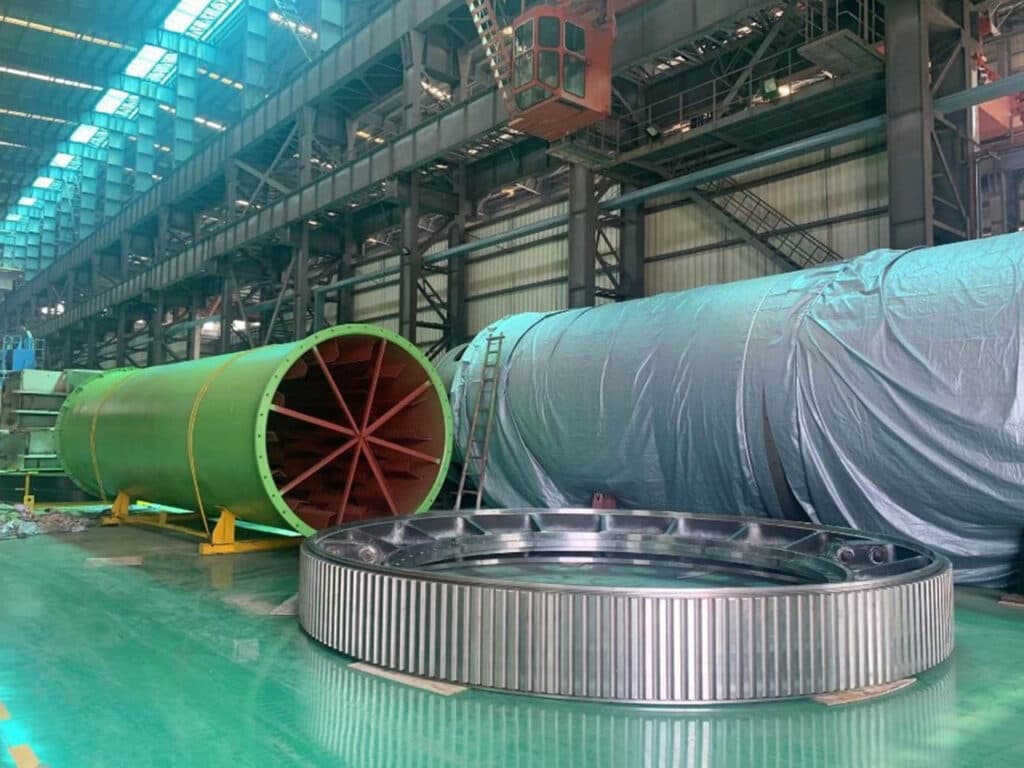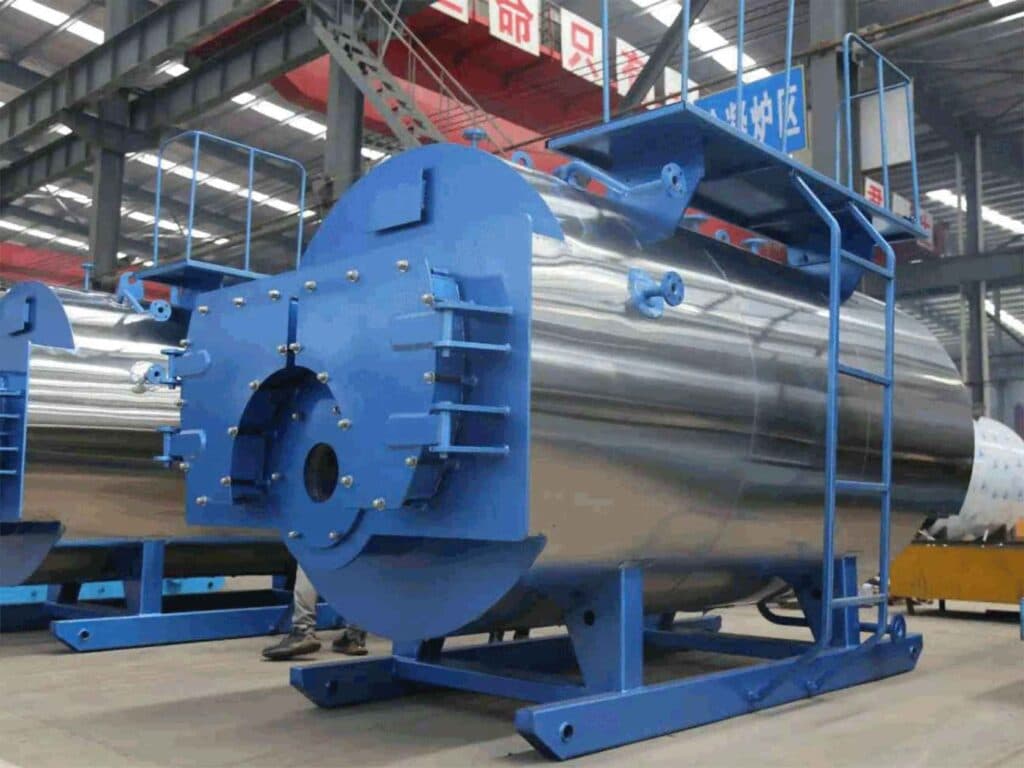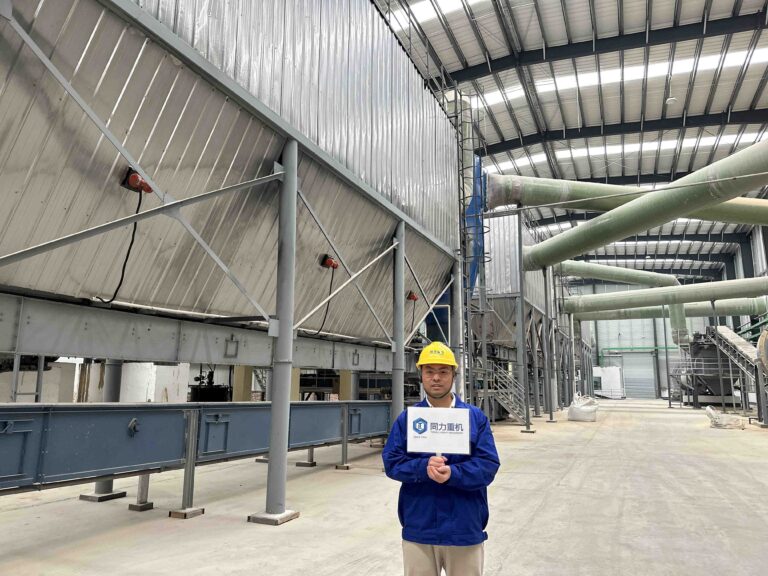NPK Compound Fertilizer
Production Line
Tongli's N (Nitrogen) P (Phosphorus) K (Potassium) fertilizer production lines offer capacities ranging from 50,000 tons/ year to 300,000 tons/ year.
Production Line Equipment List

Main Equipment
- Fertilizer Granulator
- Fertilizer Dryer
- Fertilizer Cooler
- Fertilizer Coating machine

Sieving Equipment
- Rotary screener/Trommel
- Vibrating Screener

Crushing Equipment
- Bulk Crusher
- Cage Crusher
- Chain Crusher
- Ton Bag Crusher

Conveying Equipment
- Belt Conveyor
- Bucket Elevator
- Scraper Conveyor
- Screw Conveyor

Dust Removal Equipment
- Bag House Dust Collector
- Cyclone Dust collector
- Glass Fiber Chimney(FRP)
- Tail Gas Washing Tower(FRP)

Automatic Control System
- Automatic-batching system
- Automatic-packaging system
- Automatic-bagging system
- Automatic-palletizing system

Low Voltage Power Distribution System
- LV Control System NPK Fertilizer Plant
- LV Control System BB Fertilizer Plant
- LV Control System high tower prilling

Hot Air Blast Furnace Equipment
- Coal-Fired Hot Air generator
- Natural gas fired Hot Air generator
- Diesel-fired Hot Air generator
- Biomass-fired Hot Air Generator

Other General Equipment
- Centrifugal Blower Fertilizer Production
- Steam Boiler
- Coating Agent Melting Tank
- Submerged Pump Tail Gas
NPK compound fertilizer production line technical parameters
| Item | Overall Dimensions L x W x H(mm) | Prod Capacity (t/h) | Power(kw) | Quantity(set) |
|---|---|---|---|---|
| Automatic-batching | 2000x1000x500 | 10-40 | 1.1+1.1 | 6 |
| Pan Mixer | 2330X1070X1200 | 3-5 | 15 | 2 |
| Rotary Drum Granulator | 9000x2200x2200 | 15-20 | 45 | 1 |
| Rotary Drum Dryer | 30000x2600x2600 | 20 | 45 | 1 |
| Rotary Drum Cooler | 23500x2600x2600 | 20 | 30 | 1 |
| Rotary Drum Screener | 8000x2700x2000 | 20 | 15 | 3 |
| Rotary Drum Coater | 8000x2000x2000 | 5-8 | 15 | 1 |
| Chain Crusher | 1250x1000x2100 | 2-8 | 22 | 1 |
| Product Silo | 2150x2150x4100 | 8-15 | N/A | 1 |
| Automatic Packer | 3000x3000x4000 | 1000bags/h | 1.5 | 2 |
| Belt Conveyor | N/A | 20-30t/h | 5.5 | 12 |
| Dust Settling Chamber | 5000x4000x5500 | N/A | N/A | 2 |
| Hot Blast Stove | 8000x2200x3000 | 500kcal | 35 | 1 |
Raw materials for NPK fertilizer production line
Nitrogen source
This can be in the form of ammonium nitrate, ammonium sulfate, urea, or other nitrogen-rich compounds. Typical raw materials for N content used in fertilizer plant are from Urea, MAP, DAP.
Phosphorus Sources
Phosphorus Sources: Common sources of phosphorus include monophosphate (SSP), triple superphosphate (TSP), diammonium phosphate (DAP) or mono ammonium phosphate (MAP).
Potassium sources
Potassium can be obtained from potassium chloride (KCl), potassium sulfate (K2SO4), or other potassium-containing compounds used in various industrial and agricultural applications.
Secondary Nutrients
Depending on the specific formulation, additional secondary nutrients such as calcium (Ca), magnesium (Mg), and sulfur (S) may also be included to enhance plant growth.
Micronutrients
Trace elements such as iron (Fe), manganese (Mn), zinc (Zn), copper (Cu), boron (B), and molybdenum (Mo) are commonly added as micronutrients to enhance plant growth and ensure optimal health.
NPK Production Process
Common raw materials for NPK compound fertilizer production lines include nitrogen sources such as urea, ammonium sulfate, ammonium nitrate, and ammonium chloride, phosphorus sources such as phosphate rock powder, monoammonium phosphate, and diammonium phosphate, and potassium sources such as potassium chloride, potassium sulfate, and potassium nitrate. These raw materials are mixed according to different ratios, granulated by a granulator, dehydrated by a dryer and a cooler, and surface hardened by a coating machine. Finally, NPK compound fertilizer granules are made and sold on the market.
Raw material crushing is the first process in the compound fertilizer production line. According to the different conditions of the raw materials, TONGLI will configure four different crushers, such as urea crusher, DAP crusher, bulk crusher (for bulk materials), and double-cage crusher (for materials with high fineness requirements). For products with particles that are too large after screening, we are equipped with chain crushers(chainmill) for secondary crushing. If the raw materials are purchased in the form of ton bags, we will be equipped with ton bag crushers. The advantage of using a ton bag crusher is that it saves labor and time, and can directly crush ton bags. After all the raw materials are crushed to the size required by the process, an automatic batching system will be used. According to different formulas, the high-precision electronic belt scale of compound fertilizer is used for corresponding proportioning, and then enters the granulator for granulation.
Before the raw materials enter the granulator, they need to be mixed. This will make the composition of the NPK compound fertilizer granules more uniform. Usually, we use disc mixers and agitator mixers. In the NPK compound fertilizer production line, TONGLI usually uses disc mixers because it has a large processing capacity and good mixing effect. In combination with the variable frequency speed control feeding belt conveyor, it can maximize the homogenization of the raw materials, thereby improving the granulation effect of the granulator.
The first rotary steam granulator for compound fertilizer in China was produced by Tongli in 1990, achieving a breakthrough from 0 to 1. Traditional granulators need to add water, which increases the workload of subsequent fertilizer dryers and fertilizer cooling machine, while the use of steam perfectly solves the energy consumption problem. High-temperature steam increases the ball formation rate of raw material powder in the granulator, effectively reduces energy consumption, and improves the quality of fertilizer. Inside the granulator, Tongli uses a gravity dust cleaning system to achieve a self-cleaning function through the dead weight of the polymer rubber sheet. At the same time, double-layer sealing devices and unloading covers are installed at the front and rear ends of the granulator to reduce dust emissions.
Drying is a crucial Step in the production of compound fertilizer. Failure to completely remove moisture will directly affect the quality of the finished product, including the yield, strength and appearance, which will significantly affect the overall output. Rotary Drum Dryer is a key equipment to increase the output of compound fertilizer plant, and its quality directly affects the output and quality of compound fertilizer. Our dryer has three main features: high output, good quality and long service life. In order to improve the sealing effect, we installed labyrinth seals and felt seals at the front and rear of the dryer, which effectively improved the sealing efficiency. The dryer is equipped with three different types of lifting plates: spiral type, vertical lifting type and bulk material lifting plate, so that the material can circulate in the dryer, thereby improving the drying efficiency. At the same time, our dryer is designed with an interface at the head discharge hood, which can be connected to a Bag house dust collector or a cyclone dust collector. In this way, the dust generated during the drying process can be directly collected by the dust removal system, thereby achieving excellent dust removal and emission effects and meeting emission standards.
Semi-finished fertilizer coming out of the dryer, it will enter our drum-type compound fertilizer cooler. The main function of the cooler is to further remove moisture from the compound fertilizer raw materials. Because if the temperature of the compound fertilizer is too high when it enters the next coating process, it will affect its overall strength and appearance, so the temperature needs to be lowered by the cooler. Our cooler adopts a convection design, and the air is supplied by the centrifugal blower(fan) at the tail. The material contacts the opposite direction of the air supply airflow, thereby improving the cooling effect. Another feature of the cooler is that similar to the dryer, it is equipped with 10 to 20 sets of random devices on the outside to prevent the material from sticking to the inner wall during operation. These devices are reasonably distributed and calculated to effectively reduce the phenomenon of material sticking to the wall, thereby increasing production.
When the material comes out of the cooler, it will enter the drum screen. TONGLI provides two types of screening machines: vibrating screen and rotary screen. The vibrating screen has a higher processing capacity per unit area, but more dust; while the drum screen has a smaller processing capacity per unit area, but the dust removal effect is better, so now most compound fertilizer manufacturers in China choose to use drum screen to improve environmental performance. The drum screen has an advanced structure and adopts a central shaft transmission method, which has better strength. The screen is made of 304 stainless steel, and the size of the SS304 screen is between 24 and 22 mm. There is a dust suction port on the top of the drum screen, which is connected to either the bag house dust collector or dedusting cyclone to effectively control the dust during the screening process. Unqualified materials are transported to the main feeding belt conveyor through the recycle belt conveyor or scraper conveyor, and then enter the chain crusher for secondary crushing. In this way, the compound fertilizer materials are cyclically crushed and recycled in the system, effectively improving the production line capacity.
After the material passes through the drum primary screen, it will enter the drum fine screen. The mesh size of the primary screen is about 24 mm, while the mesh size of the drum fine screen is about 22 mm. This is equivalent to further screening the material. Larger particles will enter the chain crusher for crushing, while dust that is too small will be collected by the dust collector, then pass through the FRP exhaust gas scrubber and the Venturi scrubber and re-enter the granulator for re-granulation.
Coating is a key process in compound fertilizer production. Its function is to introduce the finished products after rotary screening machine and cooling machine into the coating machine for surface treatment. The coating machine system is relatively complex. In addition to the coating machine itself, it also includes a coating oil tank, which is responsible for providing coating oil, and an automatic batching scale, which is used to control the amount of compound fertilizer entering the coating machine. Since the amount of coating oil needs to match the proportion of the finished product ingredients, a DCS control system is required to adjust the speed of automatic batching and the amount of coating oil. At the same time, during the coating process, there is also an anti-caking agent screw conveyor to convey anti-caking agents to prevent compound fertilizer particles from agglomerating or scattering. The anti-caking agent is quantitatively supplied to the coating machine through DCS control. In this way, the anti-caking agent and coating oil of the finished product can be evenly distributed in the coating machine, avoiding the agglomeration or scattering of particles. After coating, the strength of compound fertilizer particles can usually reach about 20 Newtons. In addition, coating can also change the color and appearance of the finished product, such as dyeing it blue or other colorful colors.
Regarding the finished product packaging machine of compound fertilizer, we provide two solutions: one is a semi-automatic packaging system and the other is a fully automatic packaging system. The traditional double-cylinder packaging scale has been eliminated, and now the main automatic quantitative packaging scale with servo motor is used. This servo motor packaging scale is faster and more accurate, and the packaging speed can reach 800 to 1,000 bags per hour. The scale body of the packaging scale is made of S304 stainless steel, with a thickness ranging from four to eight millimeters. The main electronic components are from Schneider, and the pneumatic components are imported from Japan. After the material comes out of the fertilizer coating machine, it first enters the buffer silo of the product packaging scale, and then passes through the automatic quantitative packaging below. The system is also equipped with automatic folding and automatic sewing systems to achieve semi-automatic packaging. If you have high requirements for automation, then the fully automatic packaging system will better match your needs. The difference lies in whether the automatic bagging machine is used in the bagging process. The automatic bagging machine can improve efficiency and save labor, but the investment cost is higher.
After the finished compound fertilizer is weighed and bagged by the packaging scale, it enters the palletizing system. This system is mainly realized by a fully stainless steel SS304 conveyor system, including the supporting legs. After the fertilizer bags are packed, they are transported bag by bag to the bottom of the palletizing robot machine for stacking. Usually we use ABB or Fanuc robot arms, with reliable quality steel trusses, and the speed is about 1000 to 1200 bags per hour. There are three types of palletizers. One is one machine with one rudder, which is the most common form; the other is one machine with two rudders, which is suitable for high production. Compound fertilizer production lines usually use single-grip palletizer systems, and double grippers are rarely used. In addition, the system is equipped with a conveying system and an automatic rewinding system. For companies that attach great importance to the modernization of the factory, our terminal machine is equipped with a pallet warehouse. This pallet warehouse makes the entire process fully automated, but the cost is also high. At the same time, the automatic pallet warehouse has very strict requirements on the material and shape of the pallet. Therefore, for companies with limited budgets, we do not recommend the terminal machine system with a pallet warehouse. On the contrary, if the requirements for automation are not high, you can choose our conventional wooden pallet system without the need for a pallet warehouse.

NPK Production Line Advantages
- Steam drum pelletizing production line has wide adaptability to raw materials.
- Steam drum pelletizing production line has high output, and the pelletizing rate can reach 70%.
- The rotary drum granulation adopts steam heating, low moisture content after the material becomes ball, high drying efficiency.
- The main equipment is equipped with manhole door and observation window, which can observe the running condition of materials at any time.
- Steam drum pelletizing production line has stable output and long service life.
- The dryer part is lined with SS304 stainless steel plate to prolong the service life.
- The granulator is lined with polymer liner, and the liner falls down due to gravity to achieve the function of automatic cleaning.
- Tongli has rich experience in manufacturing, installation and commissioning of NPK compound fertilizer drum granulation production line equipment.




Project Case 2024
- In 2024, Tongli established 4 organic-inorganic compound fertilizer production lines with an annual output of 200,000 tons in Tanzania and Kenya. The main raw materials are cow dung and urea, MAP, DAP.
- The design of this production line fully considered the abundant local cow dung resources.
- The production process is that the cow dung is fermented and turned, then mixed with other nitrogen, phosphorus and potassium raw materials, and finally made into organic and inorganic fertilizers after granulation, drying, cooling and coating.
Why Choose TONGLI ?
We found many manufacturers for quotations, and Tongli's price was the highest. However, after visiting Tongli's factory and their project cases, I finally chose Tongli. The design concept of the entire production line is completely different from other companies, and the manufacturing capabilities and production The craftsmanship completely surpasses all other manufacturers

Private Owner Africa
Our company's first production line was purchased from Henan, China. They provided a lifetime warranty, but the entire line was scrapped and could not continue to operate within 1 year. After many investigations, we finally found zhejiang tongli, the largest compound fertilizer equipment manufacturer in China. The quality of the equipment provided by tongli is completely superior to that provided by other manufacturers.

Procurement Manager Africa
Our company has purchased 4 lines from tongli. The material selection, design concept and manufacturing level of tongli equipment are unquestionable. However, as an old customer, I would recommand tongli use more carbon steel on the equipment instead of SS304, so that the total price can be cheaper.

Pupuk Urea Procurement Indonesia
If you need high-quality products and reliable production lines, tongli will be the first choice. If there are no requirements for quality, there are enough manufacturers on the market to give very, very low prices. The only reason why I chose tongli is that they are very responsible and trustworthy. They will not raise the price after signing the contract. Believe or not, many manufacturers in henan who start with very low prices will do this.

Private Business owner Mid-East Asia
Our Products
We are the industry heads and produce the most reliable and trendy fertilizer production line solution you are looking for.
NPK compound fertilizer steam granulation solution
Suitable for making compound fertilizers, organic fertilizers and mixed fertilizers with diversified formulas with large output
NPK roller extrusion granulation method production
Save energy consumption, flexible output, small investment
High tower prilling method npk fertilizer production
Large investment, large output, suitable for making high-nitrogen NPK compound fertilizer
BB fertilizer blending line
Small investment, flexible output, and can mix a variety of formulas










